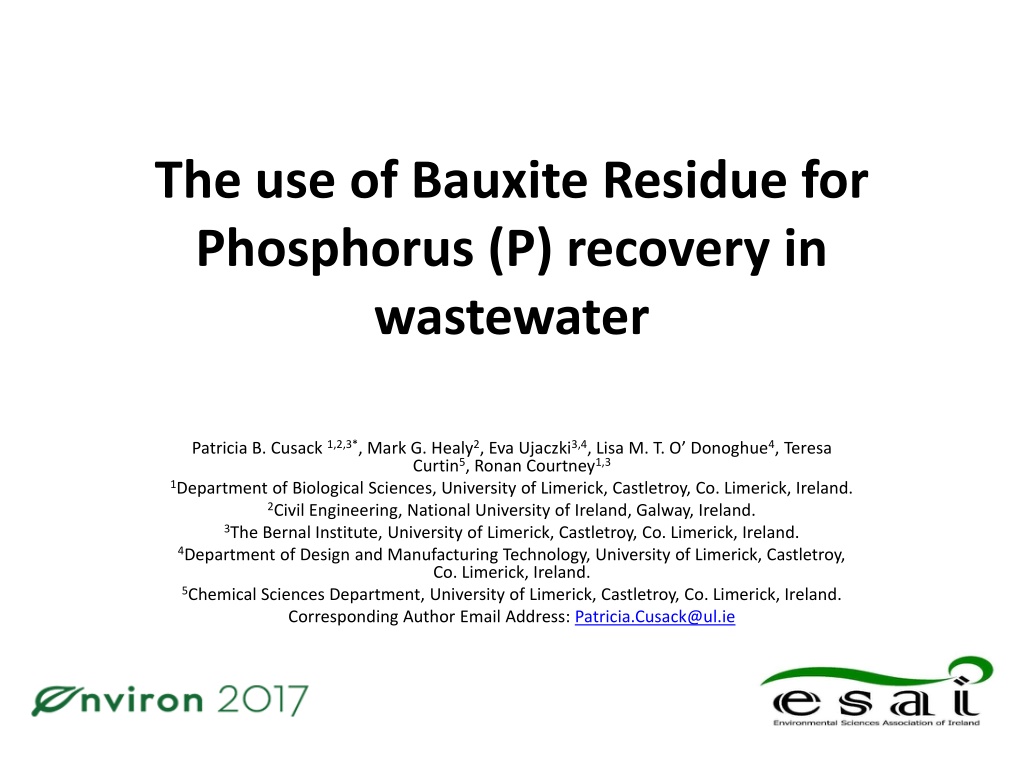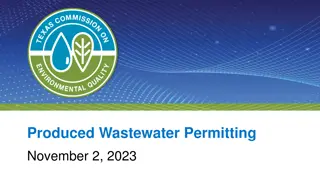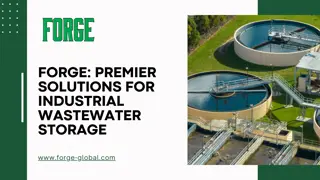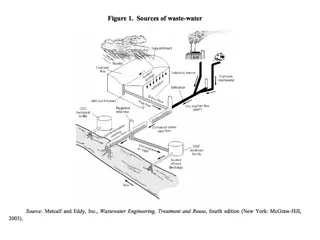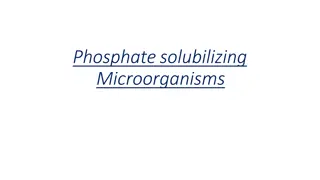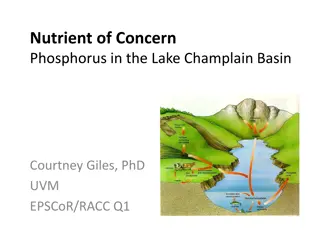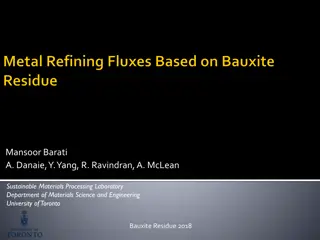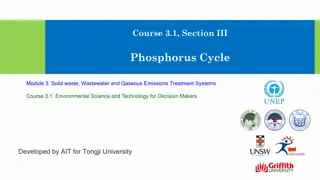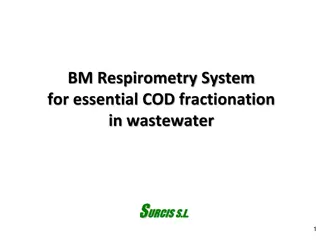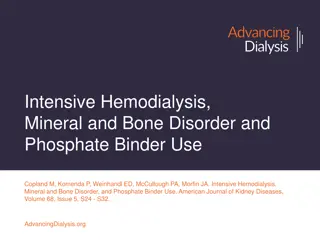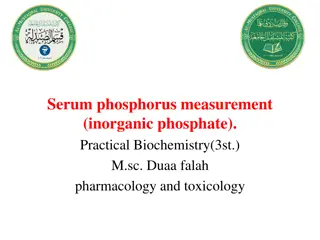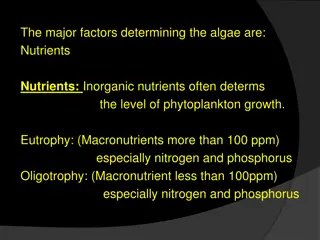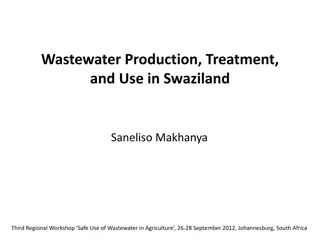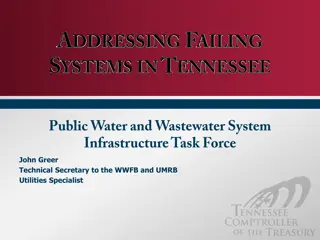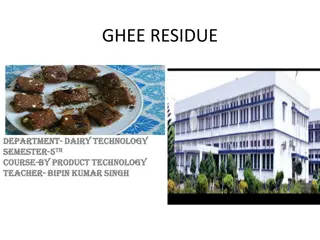Utilization of Bauxite Residue for Phosphorus Recovery in Wastewater
This study explores the potential of using bauxite residue, a by-product of the aluminum industry, as an adsorbent for phosphorus recovery in wastewater treatment. With the increasing demand for phosphorus and declining phosphate rock supplies, alternative methods like utilizing bauxite residue could provide a sustainable solution. The research delves into the characteristics of bauxite residue, its storage considerations, and its effectiveness in removing phosphorus from wastewater. By repurposing this industrial waste, not only can phosphorus be recovered efficiently, but environmental concerns related to eutrophication can also be addressed.
Download Presentation

Please find below an Image/Link to download the presentation.
The content on the website is provided AS IS for your information and personal use only. It may not be sold, licensed, or shared on other websites without obtaining consent from the author. Download presentation by click this link. If you encounter any issues during the download, it is possible that the publisher has removed the file from their server.
E N D
Presentation Transcript
The use of Bauxite Residue for Phosphorus (P) recovery in wastewater Patricia B. Cusack 1,2,3*, Mark G. Healy2, Eva Ujaczki3,4, Lisa M. T. O Donoghue4, Teresa Curtin5, Ronan Courtney1,3 1Department of Biological Sciences, University of Limerick, Castletroy, Co. Limerick, Ireland. 2Civil Engineering, National University of Ireland, Galway, Ireland. 3The Bernal Institute, University of Limerick, Castletroy, Co. Limerick, Ireland. 4Department of Design and Manufacturing Technology, University of Limerick, Castletroy, Co. Limerick, Ireland. 5Chemical Sciences Department, University of Limerick, Castletroy, Co. Limerick, Ireland. Corresponding Author Email Address: Patricia.Cusack@ul.ie
Objectives of presentation 1. Some background on Critical Raw Materials (CRM) and phosphorus 2. Bauxite residue, what is it? 3. Bauxite residue as an adsorbent for phosphorus (P) 4. My study and results
Critical raw materials (European Commission (EC) (2010))
Critical raw materials (European Commission (EC) (2010))
Phosphorus Phosphorus is a non-metal and a key component in the composition of animals and plants; essential for successful crop yields. Phosphorus is added to land through the use of fertilisers. 1. Organic fertiliser phosphorus sourced from the manure. 2. Mineral fertiliser phosphorus sourced from phosphate rock. Demand projected to increase with increasing population; production costs increasing. Therefore decline in phosphate rock supplies. Eutrophication Phosphorus one of the major nutrients contributing to eutrophication of lakes/natural waters. Table 1 Estimation of remaining phosphate rock reserves. Estimated lifetime of reserves Estimated year of depletion Reference 80 years 93 years 90 years 2080 2102 2099 Smil 2000 Fixen 2009 Vaccari 2009
Methods of P removal from wastewater Chemical Precipitation Biological Phosphate Removal (BPR) Adsorbents
Bauxite residue what is it? More commonly known as red mud Storage practices and management A by-product produced in the aluminium industry Approximately 0.8t of bauxite residue produced per 1t of alumina Globally: Roughly 150Mt is being produced annually (Evans 2016)
Bauxite residue storage considerations Highly alkaline High electrical conductivity (EC) Fine particle size (Gr fe et al. 2009)
Bauxite residue as an adsorbent for P High composition of iron (Fe) and aluminium(Al) oxides Adsorption of phosphates at the edge of Al/Fe-O
Previous studies Table 2 Previous P adsorption studies that have been carried out using bauxite residues, untreated and treated residues, and their recovery efficiencies. Recovery Technique Factors investigated Type of water Initial P concentration of the water 5-100mg P L-1 P Recovery Efficiency Reference 0.204mg P g-1 Untreated bauxite residue Batch adsorption experiment Batch adsorption experiment Batch adsorption experiment Kinetics, pH and temperature Contact time (3, 6, 24, 48hr) Synthetic water Grace et al. 2015 20-400mg P L-1 7.027mg P g-1 Gypsum Treated Synthetic water Lopez et al. 1998 0.5-2mg P L-1 6.5-14.9 mg P g-1 Brine treated bauxite residue pH, ionic strength, time Synthetic water Akhurst et al. 2006 200mg P L-1 55.72mg P g-1 Acid and brine treated bauxite residue Batch adsorption experiment Kinetics and isotherms Synthetic water Ye et al. 2014
Objectives of this segment of the study To characterise and treat bauxite residue from two different refineries, with seawater and gypsum. To investigate the effect of the treated bauxite residue on P adsorption.
Step 1: Treatment of bauxite residue Refinery 2 Refinery 1 Unseparated Bauxite Residue Coarse Fraction Fine Fraction Gypsum Gypsum Seawater Seawater Gypsum Seawater (9 media for the batch adsorption study)
Step 2: Characterisation of bauxite residue samples 1. Physicochemical properties 2. Mineralogiclal composition 3. Elemental composition
Physicochemical properties of the bauxite residue Parameter Fine fraction Fine fraction +gypsum Fine fraction+ seawater Coarse fraction Coarse fraction + gypsum Coarse fraction +seawater Unseparated Unseparated + gypsum Unseparated +seawater pH 10.8 0.10 8.7 0.04 9.02 0.07 11.4 0.31 7.95 0.16 6.79 0.08 11.9 0.06 9.17 0.02 9.49 0.01 EC ( S cm-1) 704 29.9 1338 3.5 3080 17.3 856 1.53 909 2 916 1.53 1184 17.3 1219 7.21 5323 172 % Water 23.5 0.65 28.9 0.6 32.1 1.72 0.39 0.2 0.82 0.18 3.13 0.72 28 0.54 35.3 1.32 36.5 0.16 d10 ( m) d50 ( m) d90 ( m) 0.6 0.09 2.43 0.29 6.02 0.86 1.37 0.22 3.56 0.59 7.12 1.98 1.26 0.05 3.52 0.11 7.69 1.97 1.27 0.48 5.13 0.63 12.0 1.27 1.11 0.24 3.68 0.4 9.51 0.25 1.66 0.84 3.69 0.5 7.0 0.13 1.3 0.04 3.69 0.13 10.1 2.4 1.49 0.05 4.11 0.39 9.81 2.68 1.08 0.74 3.47 0.98 7.17 3.25 Total porosity (%) 50.0 2.25 54 6.72 50.3 2.16 8.4 0.83 15.8 1.19 11.8 1.96 61.8 1.17 55.03 0.62 55.1 0.88 Bulk density (g cm-3) 1.5 0.02 1.41 0.04 1.46 0.02 2.47 0.007 2.44 0.01 2.45 0.02 1.3 0.03 1.28 0.05 1.25 0.16 Particle size density (g cm- 3) 2.99 0.1 3.11 0.5 2.94 0.12 2.81 0.21 2.65 0.4 2.7 0.14 3.41 0.06 2.85 0.08 2.85 0.07 PZCpH 7 1.21 3.43 0.73 6.28 0.99 2.85 0.75 5.45 0.33 5.43 0.22 6.16 0.21 6.32 0.51 4.43 0.09 CEC (K)(cmol kg-1) n.a.* n.a.* n.a.* 63.3 2.56 64.1 3.41 60.1 2.96 57.5 2.13 56.4 3.49 48.9 13.7 *n.a. = not available
Physicochemical properties of the bauxite residue Parameter Fine fraction Fine fraction +gypsum Fine fraction+ seawater Coarse fraction Coarse fraction + gypsum Coarse fraction +seawater Unseparated Unseparated + gypsum Unseparated +seawater pH 10.8 0.10 8.7 0.04 9.02 0.07 11.4 0.31 7.95 0.16 6.79 0.08 11.9 0.06 9.17 0.02 9.49 0.01 EC ( S cm-1) 704 29.9 1338 3.5 3080 17.3 856 1.53 909 2 916 1.53 1184 17.3 1219 7.21 5323 172 % Water 23.5 0.65 28.9 0.6 32.1 1.72 0.39 0.2 0.82 0.18 3.13 0.72 28 0.54 35.3 1.32 36.5 0.16 d10 ( m) d50 ( m) d90 ( m) 0.6 0.09 2.43 0.29 6.02 0.86 1.37 0.22 3.56 0.59 7.12 1.98 1.26 0.05 3.52 0.11 7.69 1.97 1.27 0.48 5.13 0.63 12.0 1.27 1.11 0.24 3.68 0.4 9.51 0.25 1.66 0.84 3.69 0.5 7.0 0.13 1.3 0.04 3.69 0.13 10.1 2.4 1.49 0.05 4.11 0.39 9.81 2.68 1.08 0.74 3.47 0.98 7.17 3.25 Total Porosity (%)d 50.0 2.25 54 6.72 50.3 2.16 8.4 0.83 15.8 1.19 11.8 1.96 61.8 1.17 55.03 0.62 55.1 0.88 Bulk Density (g cm-3) 1.5 0.02 1.41 0.04 1.46 0.02 2.47 0.007 2.44 0.01 2.45 0.02 1.3 0.03 1.28 0.05 1.25 0.16 Particle Size Density (g cm- 3) 2.99 0.1 3.11 0.5 2.94 0.12 2.81 0.21 2.65 0.4 2.7 0.14 3.41 0.06 2.85 0.08 2.85 0.07 PZCpH 7 1.21 3.43 0.73 6.28 0.99 2.85 0.75 5.45 0.33 5.43 0.22 6.16 0.21 6.32 0.51 4.43 0.09 CEC (K)(cmol kg-1) n.a.* n.a.* n.a.* 63.3 2.56 64.1 3.41 60.1 2.96 57.5 2.13 56.4 3.49 48.9 13.7 *n.a. = not available
Mineralogical composition of the bauxite residue Parameter Fine fraction Fine fraction +gypsum Fine fraction+ seawater Coarse fraction Coarse fraction + gypsum Coarse fraction +seawater Unseparated Unseparated + gypsum Unseparated +seawater Fe2O3 (%) 43.9 1.1 3.5 0.8 41.8 1.2 64.0 5.1 61.4 3.0 69.9 3.8 43.9 0.6 47.9 0.5 53.3 5.8 Al2O3 (%) 12.7 0.6 11.3 1.0 11.1 2.5 19.4 1.8 11.1 0.6 7.4 0.7 14 1 11.2 0.3 11.4 2.2 CaO (%) 5.9 0.2 8.2 0.5 4.4 0.3 1.1 0.2 7.6 0.4 1.2 0.1 5.6 0.1 7.7 0.3 3.2 0.5 SiO2 (%) 8.6 0.7 8.5 0.9 8.6 1.7 2.6 0.3 1.3 0.2 1.4 0.2 9.4 0.5 5.1 0.4 4.3 0.3 TiO2 (%) 2.4 0.3 2.1 0.1 2.7 0.1 0.9 0.1 1.0 0.1 2.1 0.6 2.5 0 2.3 0.1 2.3 0.5 MgO (%) 3.6 1.3 40.6 0.6 3.1 1.0 4.7 1.8 3.6 0.8 2.6 0.6 4.1 0.6 3.8 0.9 3.2 1.6 Other (%) 22.9 25.8 28.3 10.3 15 15.4 20.5 22 22.3
Main elemental composition of the bauxite residue Parameter Fine fraction Fine fraction +gypsum Fine fraction+ seawater 80608 3090 Coarse fraction Coarse fraction + gypsum 48851 2336 Coarse fraction +seawater 45855 2769 Unseparated Unseparated + gypsum Unseparated +seawater Al (mg kg-1) 72538 139 0 81095 1219 45855 2769 67296 3343 65389 1326 64189 595 Fe (mg kg-1) 338571 30 57 289459 185 9 298282 493 7 434739 998 0 460078 2304 3 434740 998 1 353392 1000 3 328114 449 8 332251 343 5 Mg (mg kg-1) <LOD* 122.28 4.9 6 163 37 1047 25.6 18.32 4.78 18.3 4.8 109 3.9 150 9 2203.8 134 K (mg kg-1) 399 1.47 454 29 1108 41 255 38 195 23 255.2 38 399 13 359 11 1048 63.2 Si (mg kg-1) 232 62 256 92 245.7 35 213 6.6 234 34 212.9 6.6 276 20 285 34 258.5 11.7 Na (mg kg-1) 28647 261 38180 352 41864 2012 8804 666 5935 114 8804.8 666 25514 317 23703 499 31974 1087 Ti (mg kg-1) <LOD* <LOD* <LOD* 1395 196 1309 100 1265 22 1382 38 1288 120 1233 46 Ca(mg kg-1) 46855 107 3 51641 485 17159 413 4152 490 12771 823 4152.4 490 15084 358 42703 2383 14820 926 P(mg kg-1) 955 0.57 962 99 1018 15 1040 23 1011 59 1039.6 23 1298 26 1220 10 1320 53.8 *<LOD = Below the limit of detection
Step 3: Batch adsorption study 9 different media used: Untreated fine fraction, seawater treated, gypsum treated Untreated coarse fraction, seawater treated, gypsum treated Untreated unseparated bauxite residue, seawater treated, gypsum treated Concentration range: 0 to 150mg P L-1 Shaken for 24 hours
Maximum adsorption capacity Table 6 Removal rate of P using each of the nine media. R2 Media Isotherm Qmax (mg P g-1 media) Untreated bauxite Unseparated Langmuir 0.992 1 Fine Fraction Langmuir 0.996 0.375 Coarse Fraction Langmuir 0.982 0.346 Gypsum treatment bauxite Unseparated Langmuir 0.993 2.73 Fine Fraction Langmuir 0.971 2.46 Coarse Fraction Langmuir 0.999 1.39 Seawater treated bauxite Unseparated Langmuir 0.995 1.92 Fine Fraction Langmuir 0.995 0.475 Coarse Fraction Langmuir 0.999 0.66
Present and future work . Permeability testing to achieve a suitable media mix to set up column trials. Column trials with wastewater. Look at media volume, kinetics of adsorption, effect of retention time and flow rate.
References Akhurst, D.J., Jones, G.B., Clark, M. and McConchie, D., 2006. Phosphate removal from aqueous solutions using neutralised bauxite refinery residues (Bauxsol ). Environmental chemistry, 3(1), pp.65-74. European Commission (EC) (2010) Critical Raw Materials [image], available: https://ec.europa.eu/growth/sectors/raw-materials/specific-interest/critical_en [accessed 30 March 2017]. Fixen, P.E. and Johnston, A.M., 2012. World fertilizer nutrient reserves: a view to the future. Journal of the Science of Food and Agriculture, 92(5), pp.1001-1005. Grace, M.A., Healy, M.G. and Clifford, E., 2015. Use of industrial by-products and natural media to adsorb nutrients, metals and organic carbon from drinking water. Science of The Total Environment, 518, pp.491-497. Gr fe, M., Power, G. and Klauber, C., 2009. Review of bauxite residue alkalinity and associated chemistry. Clay Miner. Karawara, WA, Australia. Evans, K., 2016. The history, challenges, and new developments in the management and use of bauxite residue. Journal of Sustainable Metallurgy, 2(4), pp.316-331. Lopez, E., Soto, B., Arias, M., Nunez, A., Rubinos, D. and Barral, M.T., 1998. Adsorbent properties of red mud and its use for wastewater treatment. Water Research, 32(4), pp.1314-1322. Smil, V., 2000. Phosphorus in the environment: natural flows and human interferences. Annual review of energy and the environment, 25(1), pp.53-88. Vaccari, D.A., 2009. Phosphorus: a looming crisis. Scientific American, 300(6), pp.54-59. Ye, J., Zhang, P., Hoffmann, E., Zeng, G., Tang, Y., Dresely, J. and Liu, Y., 2014. Comparison of response surface methodology and artificial neural network in optimization and prediction of acid activation of Bauxsol for phosphorus adsorption. Water, Air, & Soil Pollution, 225(12), p.2225.
Acknowledgements Acknowledgements and thanks to the EPA for funding this project. Special thanks to my supervisors Dr. Ronan Courtney (UL) and Dr. Mark G. Healy (NUIG).
